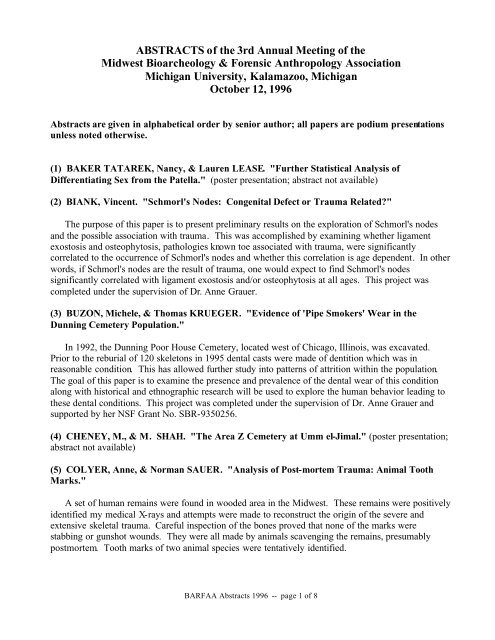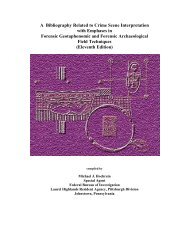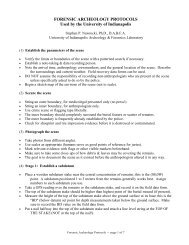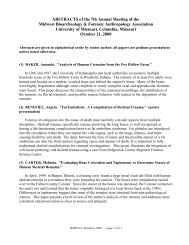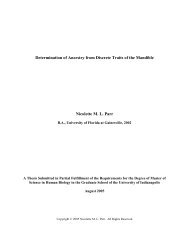Abstracts - University of Indianapolis Archeology & Forensics ...
Abstracts - University of Indianapolis Archeology & Forensics ...
Abstracts - University of Indianapolis Archeology & Forensics ...
You also want an ePaper? Increase the reach of your titles
YUMPU automatically turns print PDFs into web optimized ePapers that Google loves.
ABSTRACTS <strong>of</strong> the 3rd Annual Meeting <strong>of</strong> the<br />
Midwest Bioarcheology & Forensic Anthropology Association<br />
Michigan <strong>University</strong>, Kalamazoo, Michigan<br />
October 12, 1996<br />
<strong>Abstracts</strong> are given in alphabetical order by senior author; all papers are podium presentations<br />
unless noted otherwise.<br />
(1) BAKER TATAREK, Nancy, & Lauren LEASE. "Further Statistical Analysis <strong>of</strong><br />
Differentiating Sex from the Patella." (poster presentation; abstract not available)<br />
(2) BIANK, Vincent. "Schmorl's Nodes: Congenital Defect or Trauma Related?"<br />
The purpose <strong>of</strong> this paper is to present preliminary results on the exploration <strong>of</strong> Schmorl's nodes<br />
and the possible association with trauma. This was accomplished by examining whether ligament<br />
exostosis and osteophytosis, pathologies known toe associated with trauma, were significantly<br />
correlated to the occurrence <strong>of</strong> Schmorl's nodes and whether this correlation is age dependent. In other<br />
words, if Schmorl's nodes are the result <strong>of</strong> trauma, one would expect to find Schmorl's nodes<br />
significantly correlated with ligament exostosis and/or osteophytosis at all ages. This project was<br />
completed under the supervision <strong>of</strong> Dr. Anne Grauer.<br />
(3) BUZON, Michele, & Thomas KRUEGER. "Evidence <strong>of</strong> 'Pipe Smokers' Wear in the<br />
Dunning Cemetery Population."<br />
In 1992, the Dunning Poor House Cemetery, located west <strong>of</strong> Chicago, Illinois, was excavated.<br />
Prior to the reburial <strong>of</strong> 120 skeletons in 1995 dental casts were made <strong>of</strong> dentition which was in<br />
reasonable condition. This has allowed further study into patterns <strong>of</strong> attrition within the population.<br />
The goal <strong>of</strong> this paper is to examine the presence and prevalence <strong>of</strong> the dental wear <strong>of</strong> this condition<br />
along with historical and ethnographic research will be used to explore the human behavior leading to<br />
these dental conditions. This project was completed under the supervision <strong>of</strong> Dr. Anne Grauer and<br />
supported by her NSF Grant No. SBR-9350256.<br />
(4) CHENEY, M., & M. SHAH. "The Area Z Cemetery at Umm el-Jimal." (poster presentation;<br />
abstract not available)<br />
(5) COLYER, Anne, & Norman SAUER. "Analysis <strong>of</strong> Post-mortem Trauma: Animal Tooth<br />
Marks."<br />
A set <strong>of</strong> human remains were found in wooded area in the Midwest. These remains were positively<br />
identified my medical X-rays and attempts were made to reconstruct the origin <strong>of</strong> the severe and<br />
extensive skeletal trauma. Careful inspection <strong>of</strong> the bones proved that none <strong>of</strong> the marks were<br />
stabbing or gunshot wounds. They were all made by animals scavenging the remains, presumably<br />
postmortem. Tooth marks <strong>of</strong> two animal species were tentatively identified.<br />
BARFAA <strong>Abstracts</strong> 1996 -- page 1 <strong>of</strong> 8
(6) COLYER, Anne, & A. RAUTMAN. "Studying Dietary Change at the Pithouse to Pueblo<br />
Transition."<br />
About 1,000 years ago, populations in the Southwestern United States abandoned their longestablished<br />
use <strong>of</strong> pithouse dwellings in favor <strong>of</strong> pueblos. Researchers have long associated a change<br />
in subsistence pattern with the pithouse to pueblo transition -- that <strong>of</strong> increasing sedentism and maize<br />
dependence. Recent studies have challenged this theory. Stable isotope analysis <strong>of</strong> two skeletal<br />
populations from central New Mexico, one from a pithouse village and one from a pueblo site, suggest<br />
that not increase in maize dependence occurred at this time.<br />
(7) HARN, Dawn. "Human Remains from the Liverpool Lake Site (11Mn163)."<br />
The Liverpool Lake site is a predominately Mapple Mills (800 - 1000 A.D.) occupation with minor<br />
components <strong>of</strong> Bauer Branch, Weaver, and Mississippian. The site is situated on a natural levee <strong>of</strong> the<br />
Illinois River and has seen mostly buried by post-settlement alluvium. Many intact features were<br />
located at the waster's edge and material was observed extending outward into the river. A total <strong>of</strong> 21<br />
individuals were identified from human skeletal remains that were found scattered <strong>of</strong> the eroded<br />
surface <strong>of</strong> the site, in pit features, and in a back pr<strong>of</strong>ile trench. Non intact interments were found at the<br />
site. Three types <strong>of</strong> postmortem modifications were observed at the site -- defleshing, gnawing, and<br />
burning. The amount <strong>of</strong> postmortem modification is a striking attribute <strong>of</strong> the site. Evidence from the<br />
scorched remains, defleshing, and carnivore gnawing indicates that the fragmented human skeletal<br />
elements were not accorded burial treatment and were part <strong>of</strong> the site's refuse. The question <strong>of</strong> identity<br />
<strong>of</strong> the fragmented remains arises.<br />
(8) HITZEMANN, Nicole. "Late Woodland Patterns <strong>of</strong> Osteoarthritis in West-Central Illinois."<br />
Previous researchers have compared changes in activity levels between Archaic hunter-gatherers<br />
and Mississippian agriculturalists. While some studies indicate an increase in physical activity with<br />
the intensification <strong>of</strong> maize agriculture, others conclude the opposite. Differing suites <strong>of</strong> subsistencerelated<br />
behaviors in various regions have been used to explain this contradiction . This study focuses<br />
on the sites <strong>of</strong> Kulman (600 - 800 AD) and Schroeder Mounds (800 - 1000 AD) which encompass a<br />
limited temporal and geographic range in order to examine the transition between these two<br />
subsistence strategies. Patterns <strong>of</strong> osteoarthritis and other activity-induced pathologies <strong>of</strong> the major<br />
limb joints are analyzed.<br />
(9) HUNT, Vanessa. "Dietary Interpretation <strong>of</strong> a Plains Village Site."<br />
Trace element levels in ten individuals from the Plains Village site 39CA102 were established.<br />
These individuals range in age from newborn to young adult. Stable isotope rations will also be<br />
discussed with regard to possible dietary interpretation.<br />
(10) KNAPP, Heather, Robert MENSFORTH, & D. MEDVED. "Taphonomic Study <strong>of</strong> Rodent<br />
Gnaw Marks Among the Late Archaic Ward Site Human Skeletal Remains."<br />
Human skeletal remains recovered from the Late Archaic Ward Site were examined for the<br />
presence/absence <strong>of</strong> rodent gnaw marks (RGMs) in order to (1) document the overall frequency with<br />
which individuals displayed RGMs, (2) differentiate RGMs from premortem cut marks, (3) determine<br />
if rodents exhibited a preference for specific human bones, (4) assess the extent to which rodent<br />
BARFAA <strong>Abstracts</strong> 1996 -- page 2 <strong>of</strong> 8
gnawing activities at the Ward Site may have been opportunistic by exploring the relationships<br />
between RGMs and degree <strong>of</strong> post-depositional skeletal exposure, and (5) evaluate the extent to which<br />
rodent activities have contributed to the decay <strong>of</strong> the mortuary assemblage prior to recovery.<br />
(11) KONDRAT, James. "A New Co-Ordinate Caliper." (poster presentation; abstract not<br />
available)<br />
(12) LANGFORD, Donna. "Non-Specific Infectious Diseases in Central Illinois: Indications <strong>of</strong><br />
Health Status During the Late Woodland Period."<br />
This research project focused on the impact <strong>of</strong> nonspecific infectious disease on the human<br />
populations <strong>of</strong> Kuhlman and Schroeder Mounds. The disease process is thought to be the body's<br />
struggle to maintain health. A high frequency <strong>of</strong> disease lesions may indicate increased environmental<br />
stresses and the population's attempt to adapt. Both the Kuhlman mounds (AD 600 - 700) and<br />
Schroeder Mounds (AD 800 - 1000) sites are located in central Illinois and respectively represent the<br />
early and late phases <strong>of</strong> the Late Woodland Period. These sites may illustrate change in health status<br />
during the time or transition from hunting and gathering ton intensification <strong>of</strong> agriculture.<br />
(13) LEHER, Tamara. "A Facial Reconstruction From a Caucasoid Cemetery in North<br />
Dakota."<br />
Site 32SN194 is an unmarked Caucasoid cemetery in east-central North Dakota. Of the four<br />
burials at this site, three were juveniles, and the fourth was a female, circa 60 years <strong>of</strong> age. It was this<br />
fourth individual whose face was reconstructed. Fragile areas were protected with cotton. Erasers<br />
were cut to muscle depths for an emaciated female and glued into place and filled in, after which they<br />
were connected with strips <strong>of</strong> clay. The eyes, lips, nose, and wars were sculpted. When completed,<br />
the face was smoothed <strong>of</strong> extra marks, and aged. The process took approximately 5 days (24 working<br />
hours).<br />
(14) MASTERSON, William Jr., & E. KILBANE. "Cranial Deformation in Prehistoric Native<br />
American Populations."<br />
The presence <strong>of</strong> cranial deformation in prehistoric native American populations is not uncommon.<br />
This paper explores the pattern and frequency <strong>of</strong> cranial deformation in an archaeological population<br />
from the S.U. site in New Mexico (approximately 1550 b.p.) and works to develop hypotheses<br />
concerning possible causes <strong>of</strong> these skeletal alterations. This project was completed under the<br />
supervision <strong>of</strong> Dr. Anne Grauer and supported by her NSF Grant No. SBR-9350256.<br />
(15) MCBRIDE, David. "Osteoarchaeological Wealth in Museum Collections: Analysis <strong>of</strong> the<br />
NAGPRA Inventory."<br />
Museum collections represent a great reserve <strong>of</strong> osteoarchaeological information that is <strong>of</strong>ten under<br />
examined. This point was emphasized during the compilation <strong>of</strong> a joint inventory <strong>of</strong> human remains<br />
and associated funerary objects housed at the Illinois State Museum and Dickson Mounds Museum, as<br />
specified by the Native American Graves Protection and Repatriation Act (NAGPRA). The completed<br />
inventory contains 5,653 records representing a minimum <strong>of</strong> 5,827 individuals from at least 265 named<br />
archeological sites, which date form the Early Archaic to post contact periods. Analysis <strong>of</strong> the records<br />
BARFAA <strong>Abstracts</strong> 1996 -- page 3 <strong>of</strong> 8
has provided a valuable assessment <strong>of</strong> the nature <strong>of</strong> information contained in museum collections and<br />
its potential in osteological and archeological research.<br />
(16) MENSFORTH, Robert, & G. BAKER. "Auditory Exostoses: Potential Value <strong>of</strong> A<br />
Phenotypic Skeletal Response for Inferring Aspects <strong>of</strong> Subsistence Behavior and Health."<br />
This study examines within and between group differences in the frequencies <strong>of</strong> auditory exostoses<br />
(AEs) among a series <strong>of</strong> four Late Archaic groups from Kentucky. AEs are induced by thermal injury<br />
associated with episodes <strong>of</strong> could water exposure. Results show that adult males exhibit significantly<br />
greater frequencies <strong>of</strong> AEs compared to females in all groups examined, and that inland bluff site<br />
groups exhibit much lower frequencies <strong>of</strong> AEs compared to shell midden site. These results are<br />
discussed with respect to (1) seasonality and sex-specificity <strong>of</strong> mollusk gathering activities, and (2)<br />
their implications for inferring increased sedentism and territorial behaviors among Late Archaic<br />
peoples.<br />
(17) MORRIS, Alan. "The Cobern Street Cemetery: The Excavation <strong>of</strong> a Historic Slave<br />
Graveyard in Cape Town, South Africa."<br />
The exposure <strong>of</strong> an 18th century cemetery in downtown Cape Town in October 1994 was followed<br />
by an extensive rescue archeological excavation over the December-January period. A team <strong>of</strong><br />
volunteers excavated over 65 formal burials in 108 square meters <strong>of</strong> deposit. Nearly all <strong>of</strong> the burials<br />
were extended on their back and in wooden c<strong>of</strong>fins. A few <strong>of</strong> the deeper skeletons (perhaps earlier in<br />
time) were without c<strong>of</strong>fins and were laid on their side. Two Late Stone Age (LSA) graves were<br />
identified from below the level <strong>of</strong> the cemetery. These were "sitting" Khoikhoi burials with LSA<br />
pottery and lots <strong>of</strong> animal bone and shell in attendance. Each <strong>of</strong> these two LSA graves was a double<br />
burial, a phenomenon rarely seen in prehistoric burials in South Africa. Radiocarbon dates indicate a<br />
date a burial around 1000 years ago, indicating that these graves are unrelated to the historic cemetery<br />
above them.<br />
Although the precise date <strong>of</strong> the cemetery or an identification <strong>of</strong> who was buried there remains<br />
uncertain, the excavations yielded a rich variety <strong>of</strong> grave goods which points to both the date and<br />
identity <strong>of</strong> the occupants. All <strong>of</strong> the associated material is 18th century in origin, primarily from the<br />
second half <strong>of</strong> that century. The grave goods included whole tobacco pipes and smoking<br />
paraphernalia, brass and silver buttons, and an ornate silver box. The last date <strong>of</strong> burial is hinted at by<br />
the presence <strong>of</strong> a 1797 British penny located just above one <strong>of</strong> the burials. The fact that no reference<br />
to the graves is mentioned in the Cape Archives seems to indicate that the people buried here were<br />
probably slaves or other people toward the bottom <strong>of</strong> the hierarchy <strong>of</strong> 18th century Cape society.<br />
Archival work is continuing on the history <strong>of</strong> the site. Physical anthropological analysis <strong>of</strong> the<br />
skeletons is now underway and preliminary results should be available by early 1997.<br />
(18) MORRIS, Alan. "Ethnic Identity and the Re-Burial Issue in South Africa: The Cases <strong>of</strong><br />
Saartje and Hintza."<br />
Recent claims for the return <strong>of</strong> the remains <strong>of</strong> Saartje Baartman to South Africa from the Musee de<br />
L'Homme in Paris, and the search in Scotland for the cranium <strong>of</strong> the Zhosa chief Hintza have<br />
highlighted the importance <strong>of</strong> human remains and the issue <strong>of</strong> reburial to people in the 'new' South<br />
Africa. Baartman's case has been taken up by the Griqua National Congress which is trying to forge a<br />
new ethnic identity for the Griqua, encompassing the early historic Khoikhoi and all living people who<br />
BARFAA <strong>Abstracts</strong> 1996 -- page 4 <strong>of</strong> 8
are descended from them. In the case <strong>of</strong> Hintza, Nicholas Gcaleka is claiming the right not only to<br />
find a skull through his traditional powers as a sangoma (traditional healer), but also to speak on behalf<br />
<strong>of</strong> the Zhosa in demanding an apology from the Queen <strong>of</strong> England for the murder <strong>of</strong> Hintza by her<br />
ancestor's followers.<br />
These cases demonstrate how ethnicity can be used to claim a position in terms <strong>of</strong> land, power or<br />
financial ease. Modern science can also be appropriated to confirm or deny claims as in the ongoing<br />
case <strong>of</strong> Hintza's cranium. It is easy to choose a position with respect to either case, but what is clear is<br />
that each case is complex and the solutions to the problems presented cannot be couched in terms <strong>of</strong><br />
historical realism alone.<br />
(19) NAWROCKI, Stephen, Christopher SCHMIDT, Matthew WILLIAMSON, & Jason<br />
SANDERS. "More Historic Cemetery Recoveries in Indiana."<br />
During 1996 we performed emergency excavations at a number <strong>of</strong> historic cemetery sites in<br />
Indiana, further expanding our research interests in historic burial archeology. The first skeleton was<br />
found eroding from the banks <strong>of</strong> a reservoir at the spot <strong>of</strong> a known cemetery that was supposedly<br />
removed decades before. The second case involves as many as 10 burials that were spread across<br />
several acres before being noted by the bulldozer operator. The two burials in the third case were<br />
found below the concrete subfloor <strong>of</strong> a factory in <strong>Indianapolis</strong> as workers were excavating to install a<br />
new furnace. These two are part <strong>of</strong> a huge cemetery 'relocated' at the turn <strong>of</strong> the century.<br />
(20) NELSON, M., & Nancy BAKER TATAREK. "Taphonomic Analysis <strong>of</strong> Human Remains<br />
Recovered in a Central Ohio Arson Investigation." (poster presentation; abstract not available)<br />
(21) OVERSHINER, Gina. "Shiloh Methodist Church Cemetery: A Skeletal and<br />
Ethnohistorical Reconstruction."<br />
During the great flood <strong>of</strong> 1993, a previously forgotten mid-nineteenth century cemetery was<br />
exposed near Cedar City, Missouri; this cemetery had been associated with Shiloh Methodist Church.<br />
Skeletal and artifactual analysis <strong>of</strong> the disturbed burials revealed African American ancestry.<br />
Comparison <strong>of</strong> skeletal analysis from Shiloh with contemporaneous cemeteries, reveals that these<br />
individuals were exposed to different types <strong>of</strong> skeletal stressors. This finding agrees with historical<br />
evidence that asserts that African Americans <strong>of</strong> the Upper South were exposed to fewer stressors than<br />
their counterparts from the Deep South.<br />
(22) PETERSON, Ryan, Stephen NAWROCKI, Matthew WILLIAMSON, Christopher<br />
SCHMIDT, & Curtis TOMAK. "An Archaic Rockshelter Burial from Daviess County,<br />
Indiana."<br />
In the Fall <strong>of</strong> 1994 we excavated a human burial that had been noted two years previously as it<br />
slowly eroded from a cliff face along the West Fork <strong>of</strong> the White River. Although severely damaged<br />
by looting activities and the extremely hard matrix that surrounded it, careful excavation and<br />
painstaking preparation <strong>of</strong> the skeleton had revealed that the middle-aged female suffered from<br />
significant osteomyelitic infection <strong>of</strong> both tibiae and ankylosis <strong>of</strong> the distal tibi<strong>of</strong>ibular joints. A<br />
Middle Archaic projectile point (ca. 3500 B.C.) found directly above the interment suggests that this is<br />
one <strong>of</strong> the oldest articulated burials yet recovered in Indiana.<br />
BARFAA <strong>Abstracts</strong> 1996 -- page 5 <strong>of</strong> 8
(23) DEL PINO, David. "Forensic Anthropology and Human Rights: Genocide and the<br />
Disappeared." (poster presentation; abstract not available)<br />
(24) POLLI, Maura. "The Underclass in an Historic Industrial Community: The Role <strong>of</strong><br />
Enamel Hypoplasia Studies in Population Health Models."<br />
Nutritional conditions affecting historic populations may be inferred from skeletal remains in<br />
general and specifically from dentition. A nineteenth and early twentieth century pauper cemetery<br />
(1885 - 1925) in Milwaukee Co., Wisconsin provides an unique opportunity to further examine current<br />
use <strong>of</strong> enamel hypoplasia as an indicator <strong>of</strong> stress. A subset <strong>of</strong> the original 1649 individual population<br />
(approximately 10%) was used to (a) test the sensitivity <strong>of</strong> particular teeth to developing bands <strong>of</strong><br />
enamel hypoplasia, (b) to measure the frequency <strong>of</strong> childhood stress in the underclass <strong>of</strong> an<br />
industrializing community, (c) seek comparison data with other populations (prehistoric through<br />
contemporary) and, (d) to exam how this population fits the model <strong>of</strong> declining age <strong>of</strong> incidence.<br />
Confirming previous studies, mandibular canines were found to be most sensitive to systematic stress<br />
while the total incidence <strong>of</strong> enamel hypoplasia (<strong>of</strong> anterior teeth) in this population is approximately<br />
65%.<br />
(25) SCHMIDT, Christopher, Stephen NAWROCKI, & Matthew WILLIAMSON. "The<br />
Recovery <strong>of</strong> Dermatoglyphs from Recently Mummified Human Finger Tissues."<br />
In October <strong>of</strong> 1994 the badly decomposed body <strong>of</strong> a middle-aged white female was found along a<br />
road near Greenfield in Hancock County, Indiana. Remaining s<strong>of</strong>t tissues were damaged by carnivores<br />
and/or extensively mummified. A death scene investigator removed the dessicated fingertips and<br />
preserved them in an unsuccessful attempt to recover dermatoglyphs and establish positive<br />
identification. A review <strong>of</strong> the literature produced a solution developed in 1921 to rehydrate Egyptian<br />
mummy tissue. After some experimentation we used it to rehydrate a single fingertip, allowing the<br />
recovery <strong>of</strong> the fingerprint. Unfortunately, the individual remains unidentified. (NOTE: see Schmidt<br />
C et al. 2000. Obtaining fingerprints from mummified fingers: A method for tissue rehydration<br />
adapted from the archeological literature. Journal <strong>of</strong> Forensic Sciences 45:874-875).<br />
(26) SMITH, Maria. "Age and Gender Bias in Populations from the Rio Grande Valley, New<br />
Mexico."<br />
The sites <strong>of</strong> the Alfred Herrera and Pueblo Del Encierro from the Rio Grande Valley <strong>of</strong> Central<br />
New Mexico exhibit a distinct age and gender bias in the recovered skeletal sample. There is a<br />
disproportionate representation <strong>of</strong> mature females. Other sites in the southwest, such as Point <strong>of</strong> Pines,<br />
Grasshopper Pueblo and Black Mesa, also report female age and/or gender bias. The cause <strong>of</strong> the<br />
disparity has never been fully addressed despite some authors attempts to deal with recovery bias.<br />
Mortuary treatment as well as recovery bias will be examined at Alfred Herrera and Pueblo Del<br />
Encierro in the hope that the source(s) for the sample bias will emerge.<br />
(27) SWENSON, Diana. "Partially Decomposed and Mummified Remains from North Dakota."<br />
In October <strong>of</strong> 1995, the decomposed and partially mummified body <strong>of</strong> a 32 year old female was<br />
discovered in Rapid City, South Dakota. She was approximately 18 months postmortem. The<br />
procedure for processing the remains and the analytical protocol will be discussed. Antemortem<br />
pathological features will also be discussed in relation to their utility in identification.<br />
BARFAA <strong>Abstracts</strong> 1996 -- page 6 <strong>of</strong> 8
(28) TUCKER, Teri, & Paul SCIULLI. "A Survey <strong>of</strong> Harris Line Frequency and Distribution<br />
in Monongahela Samples."<br />
A survey <strong>of</strong> Harris line frequency and distribution in Monongahela samples: We analyzed the<br />
radiographs <strong>of</strong> the tibiae <strong>of</strong> 57 individuals (aged 1.6-57 years) from western Pennsylvania<br />
Monongahela sites for the presence and distribution <strong>of</strong> Harris lines. Subadults, adult males, and adult<br />
females each show a high frequency <strong>of</strong> affected individuals (83.3%, 78.9%, 85.0% respectively) with<br />
an average <strong>of</strong> 3.4, 3.3, and 3.6 lines. The age <strong>of</strong> occurrence <strong>of</strong> the Harris lines suggests that growth<br />
disruption-resumption is particularly likely to occur during times <strong>of</strong> rapid growth. We also discuss the<br />
possibility <strong>of</strong> selective mortality and line resorption.<br />
(29) WEIDNER, Dennis, & Paul SCIULLI. "Metric Variation <strong>of</strong> the Deciduous Teeth in Ohio<br />
Valley Populations."<br />
We obtained and compared the bucco-lingual diameters <strong>of</strong> the deciduous teeth <strong>of</strong> 527 individuals<br />
from Late Archaic (ca. 3000 BP) through Late Prehistoric populations (ca. 300 BP). Our results show<br />
that throughout this approximately 3000 year time span deciduous tooth variation and intervariation<br />
(shape) remain constant and, absolute size showed only minor fluctuations with no consistent trend <strong>of</strong><br />
increase or decrease. We interpret these data in light <strong>of</strong> the early development <strong>of</strong> the deciduous teeth<br />
and their concomitant shielding from the environment.<br />
(30) WILLIAMS, John. "A 19th Century Historic Cemetery from North Dakota."<br />
In October <strong>of</strong> 1995, gravel road repair exposed four c<strong>of</strong>fins <strong>of</strong> an unmarked cemetery in eastcentral<br />
North Dakota Historic records and recollections place this cemetery prior to A.D. 1900. Three<br />
<strong>of</strong> the four c<strong>of</strong>fins contained the skeletal remains <strong>of</strong> juveniles. These ranged in age from 1.5 to 12<br />
years. Two juveniles showed evidence <strong>of</strong> systemic stress prior to death. The fourth c<strong>of</strong>fin contained<br />
the skeletal remains <strong>of</strong> an adult female 50 - 60 years <strong>of</strong> age. Discrete and metric assessment identified<br />
the later remains as Caucasoid. These individuals represent the first non-Indian and non-forensic<br />
skeletons to be described in North Dakota.<br />
(31) WOLFE STEADMAN, Dawnie. "The Application <strong>of</strong> Population Genetic Theory and<br />
Methods to the Bioarchaeological Study <strong>of</strong> Mississippian Population Movement: It's Not That<br />
Bad!"<br />
To accurately estimate prehistoric patterns <strong>of</strong> gene flow, archaeological problems are best modeled<br />
within a population genetics framework. This paper will demonstrate that the integration <strong>of</strong><br />
bioarchaeology and population genetic theory is imperative to fully understand prehistoric population<br />
structure. Using Late Woodland, Mississippian and Oneota samples from the central Illinois valley, it<br />
will be demonstrated that a population genetics approach is more informative to estimate long-term<br />
regional population movement than current archaeological models and traditional epigenetic studies.<br />
The results indicate that significant population movement occurred at different times within and<br />
between regions than cultural diffusion models predicted. An alternative model <strong>of</strong> Mississippian<br />
population movement and biocultural interaction in west-central Illinois is presented.<br />
BARFAA <strong>Abstracts</strong> 1996 -- page 7 <strong>of</strong> 8
Copyright © 1996 by the Individual Authors<br />
The authors grant permission for this document to be copied and distributed for personal and<br />
educational use as long as proper citation is given. Commercial use <strong>of</strong> this document is forbidden<br />
without the prior consent <strong>of</strong> the authors.<br />
Suggested citation <strong>of</strong> individual abstracts (example): Biank V (1996). Schmorl's nodes:<br />
Congenital defect or trauma related? (abstract). Presented at the 3rd Annual Meeting <strong>of</strong> the<br />
Midwest Bioarcheology & Forensic Anthropology Association, Kalamazoo MI. <strong>University</strong> <strong>of</strong><br />
<strong>Indianapolis</strong> <strong>Archeology</strong> & <strong>Forensics</strong> Laboratory (http://archlab.uindy.edu).<br />
Last update 6-30-06<br />
BARFAA <strong>Abstracts</strong> 1996 -- page 8 <strong>of</strong> 8


